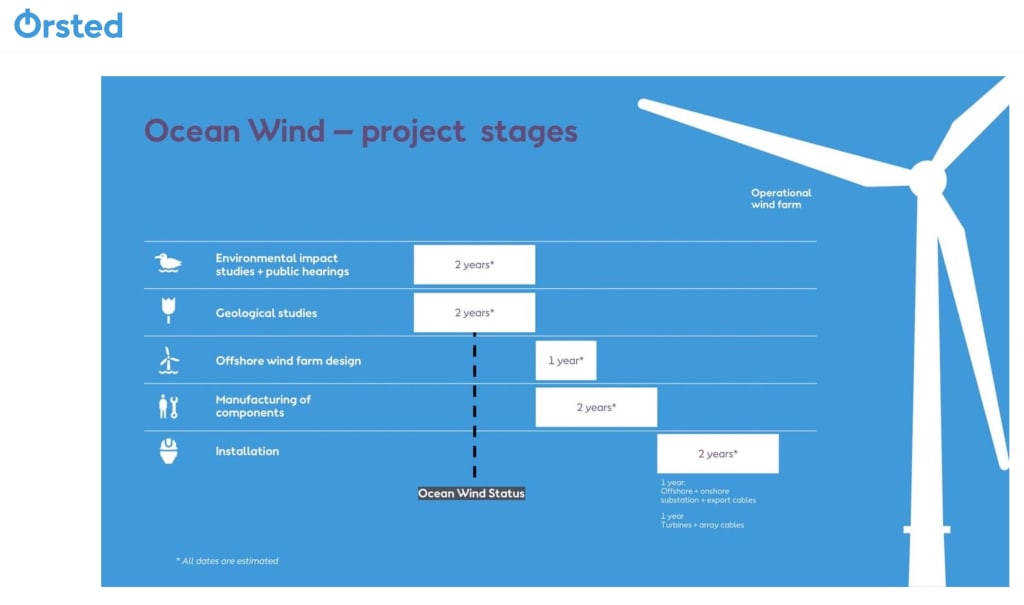Shock Waves Continue to Be Created by Offshore Wind at the Jersey Shore
Offshore Wind US

Despite bipartisan opposition, Gov. Phil Murphy reaffirmed his commitment to bringing renewable energy to the Garden State, including offshore wind farms. Many people argue about whether or not it is "clean" energy.
Murphy signed Bill A5651/S4019 into law on July 6, providing one wind developer ownership of federal tax credits intended for ratepayers. According to one estimate by state Senator Edward Durr (R-3), the value of the credits is close to $1 billion. The measure was approved just one day after President Joe Biden approved the Ocean Wind 1 project, a wind farm located 15 miles off the shore of Atlantic City.
The tax breaks were first enshrined in the Taxpayer Certainty and Disaster Tax Relief Act of 2020, legislation passed after the economic turbulence caused by COVID-19. The federal monies were originally intended to help clients with their high utility bills.
So, what caused over $1 billion to be transferred from New Jerseyans to Ørsted, the Danish global energy business building Ocean Wind 1?
According to Ørsted, it was a much-needed infusion of capital to tackle rising interest rates and inflation caused by the pandemic and geopolitical issues such as Ukraine's war. Without the federal assistance, the corporation was doubtful if Ocean Wind 1 would be profitable enough to continue. If rstead withdraws, it would be a significant blow to Murphy's long-term commitment to clean energy in the Garden State.
"We need to adjust and recognise these issues in order to help the offshore wind industry, which is New Jersey's greatest clean energy and climate solution, get off the ground and effectively takeoff," said Sierra Club state chapter director Anjuli Ramos-Busot.
Critics point out that Ørsted made record profits last year and even paid $625 million for its previous partner Eversource's portion in its offshore lease in May.
"Clearly, Ørsted isn't 'cash-strapped,'" said Cindy Zipf, executive director of Clean Ocean Action, a local charity that fights to protect waterways on a regional and national scale. "New Jersey taxpayers will now pay even more for Ørsted's offshore wind project, which also jeopardises our ocean resources," she said.Lawmakers on both sides of the aisle, as well as many advocacy groups and residents, contested the legislation that allocated the federal tax benefits. In the assembly, the bill passed with a vote of 46-30; in the senate 21-14. All state lawmakers from districts 11 and 13, covering many Two River area towns, voted against the bill.
"The company, Ørsted, made a record profit of $4.4 billion last year." In an interview with The Two River Times, Sen. Vin Gopal (D-11) commented, "This felt like a corporate welfare giveaway." "It's going to be on ratepayers' backs, and I felt they (rstead) needed to do a lot more explaining, and there were still a lot of concerns." “I generally don’t support large corporations getting big tax breaks if they can’t provide the value and show the value. For me they (Ørsted) didn’t make that argument. That’s why I didn’t vote for it,” Gopal explained.
Those opposed to offshore wind projects around the Jersey Shore were adamant about stopping them in the run-up to the bill's passage.
U.S. Rep. Chris Smith of New Jersey's fourth congressional district has asked the Government Accountability Office, a congressional watchdog, to investigate the impact of offshore wind projects in New Jersey on the environment, fishing industry, and other issues.
Clean Ocean Action urged locals to contact officials and provided frequent updates on offshore wind projects over the past month as government agencies held public hearings.
"The public is largely in the dark, and it's a top-down, fast-tracking government action that lacks science, due diligence, and good governance," Zipf explained.
Wind projects are now planned off the coast of Atlantic City, with energy export cables going north along the shore to transport power to substations.
Empire Wind, an offshore project under construction off the coasts of Monmouth County and Long Island, falls under the jurisdiction of New York.
Ocean Wind 1 by Ørsted is the largest offshore wind farm under construction along the East Coast. According to projections, Ocean Wind 1 will generate 1,100 megawatts of energy each year, enough to power 380,000-500,000 houses. The company intends to build its turbines, also known as monopiles, in 2024 and have them operational by 2025.
Atlantic Shores, another business aiming to develop a wind farm off the coast of New Jersey, mirrored Ørsted's request for government funding just before A5651/S4019. Murphy, who is committed to bringing the sector to the state, stated that he would consider Atlantic Shores' proposal.
Several energy conglomerates have major investments in offshore wind firms. Atlantic Shores is owned in part by Shell New Energies, while Empire Wind is held in part by BP and Equinor. "The fact is, fossil fuel companies own offshore wind projects and they are getting passes, including tax credits," Kari Martin, advocacy campaign manager for Clean Ocean Action, said. "It's past time for people to get informed and speak up for the ocean," Martin added.
Following the oil crises of the 1970s, the Danish government commissioned rstead to build the first offshore wind farm, Vindeby, in 1991. With the advancement of turbine technology and efficiency, many countries have commissioned offshore wind farms since Vindeby, which originally powered 2,200 Danish houses. Vindeby was shut down in 2017.
Throughout the 2000s, the United Kingdom, Sweden, and the Netherlands were the next countries to build these energy systems. Governments in India, South Korea, Taiwan, and the United States have shifted towards offshore wind in recent years since the technology has become more cost effective than alternative energy options and projects have a shorter lead time.
Offshore wind farms are a source of contention among New Jersey residents
Those opposed to such projects warn of the consequences for the ocean, wildlife, and the boating, fishing, and tourism sectors.
Those in favour say that it is an effective method to help the state shift to sustainable energy while adding a valued industry and thousands of high-paying jobs. The Sierra Club, a grassroots environmental non-profit with chapters around the United States, advocates offshore wind off the coast of New Jersey, encouraging environmentally and socially responsible project implementation. The good environmental impact and the creation of high-paying "green jobs" are cited as draw factors by the organisation.
The Sierra Club reports that New Jersey is one of the fastest warming states in the US, with a larger sea-level increase than the rest of the East Coast. Bringing offshore wind energy to the state would help to reduce climate change while also meeting Murphy's renewable energy targets. Offshore wind, according to Ramos-Busot, is "New Jersey's greatest clean energy and climate solution."
Another coastal preservation organisation, the American Littoral Society (ALS), recognises the benefits of offshore wind's clean energy, but emphasises the significance of careful design to safeguard animals and those who rely on the ocean for a living. "The acceptance of offshore wind farms in the Mid-Atlantic region hinges on where they are sited and the support of all parties that use these waters," stated Helen Henderson of the ALS in a release.
Long Branch hosted a rally in June in support of sustainably generated offshore wind. Hundreds of representatives of environmental, labour, and community organisations joined forces with local and state leaders to lobby for the projects.
About the Creator
Erik Roelans
I am founder and CEO of ER-MARINE and write about the green energy transition, renewable energy challenges, climate change, offshore wind permitting, policy dialogue, marine biodiversity, renewables and floating offshore wind development.






Comments
There are no comments for this story
Be the first to respond and start the conversation.